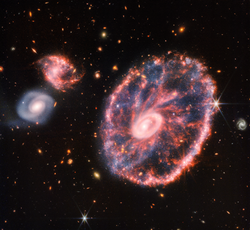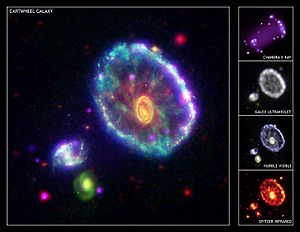Cartwheel Galaxy facts for kids
Quick facts for kids Cartwheel Galaxy |
|
|---|---|

The Cartwheel Galaxy as seen from the James Webb Space Telescope
|
|
| Observation data (J2000 epoch) | |
| Constellation | Sculptor |
| Right ascension | 00h 37m 41.1s |
| Declination | -33° 42′ 59″ |
| Redshift | 9050 ± 3 km/s |
| Distance | 500 Mly (150 Mpc) |
| Type | S pec (Ring) |
| Apparent dimensions (V) | 1′.1 × 0′.9 |
| Apparent magnitude (V) | 15.2 |
| Notable features | Ring shape |
| Other designations | |
| MCG-06-02-022a, PGC 2248 | |
| See also: Galaxy, List of galaxies | |
The Cartwheel Galaxy (also known as ESO 350-40 or PGC 2248) is a special type of galaxy called a ring galaxy. It looks like a giant wagon wheel! This amazing galaxy is about 500 million light-years away from us. You can find it in the constellation called Sculptor.
The Cartwheel Galaxy is huge, even bigger than our own Milky Way Galaxy. It has a diameter of about 144,000 light-years. It was first discovered in 1941 by an astronomer named Fritz Zwicky. He thought it was one of the most interesting and complex structures in space.
The Cartwheel Galaxy is the biggest member of a small group of four galaxies. The other three galaxies are called G1, G2, and G3. In November 2021, a supernova (a huge star explosion) called SN 2021afdx was seen in the Cartwheel Galaxy.
Contents
What Does the Cartwheel Galaxy Look Like?
The Cartwheel Galaxy has a very unusual and messy shape. It has two main rings:
- The outer ring is where lots of new stars are being born. This happens because gas and dust are being squeezed together there.
- The inner ring is closer to the galaxy's center. It also has a ring of dark dust that absorbs light.
You can also see several "spokes" or arms that connect the outer ring to the inner ring. These spokes make it look even more like a wagon wheel!
How the Cartwheel Galaxy Formed
Scientists believe the Cartwheel Galaxy was once a normal spiral galaxy. But then, about 200 to 300 million years ago, it had a head-on collision with a smaller galaxy. Imagine throwing a rock into a sandpit – that's kind of what happened!
The Cosmic Collision
When the smaller galaxy crashed through the Cartwheel Galaxy, it created a powerful wave, like a ripple in a pond. This wave was a "gravitational shock wave." It moved outward from the center of the galaxy. As the wave traveled, it pushed and squeezed the gas and dust in its path. This squeezing caused a huge burst of star formation, especially in the outer ring. That's why the outer ring looks so bright and bluish.
Returning to Normal?
After the collision, the galaxy's shape was completely changed. But scientists think the Cartwheel Galaxy is slowly starting to go back to its original shape. Over the next few hundred million years, the gas, dust, and stars that were pushed out might fall back towards the center. If this happens, the galaxy could become a spiral galaxy again. This would only happen if the other nearby galaxies (G1, G2, and G3) don't crash into it again.
Which Galaxy Caused It?
Scientists have studied the Cartwheel Galaxy group carefully. They believe that G3, one of the smaller galaxies in the group, was the one that crashed into the Cartwheel. This is because G3 has a long tail of hydrogen gas connected to the Cartwheel. This tail is like a clue, showing that G3 pulled gas away from the Cartwheel during the collision. G1 and G2 are too close to the Cartwheel now to have been the "bullet" galaxy. G3 is much farther away, which fits with how long ago the collision happened.
X-ray Sources in the Cartwheel Galaxy

The outer ring of the Cartwheel Galaxy is very bright because so many new stars are forming there. When very large and bright stars explode as supernovas, they leave behind special objects like neutron stars and black holes.
Some of these neutron stars and black holes have other stars orbiting them. When they pull matter from these companion stars, they become very powerful sources of X-rays. These are called X-ray sources. The brightest X-ray sources are probably black holes with companion stars. You can see them as bright white dots along the rim of the X-ray image of the Cartwheel Galaxy. Because so many massive stars formed in the Cartwheel's ring, it has an unusually large number of these X-ray sources.
See also
 In Spanish: Galaxia Rueda de Carro para niños
In Spanish: Galaxia Rueda de Carro para niños

